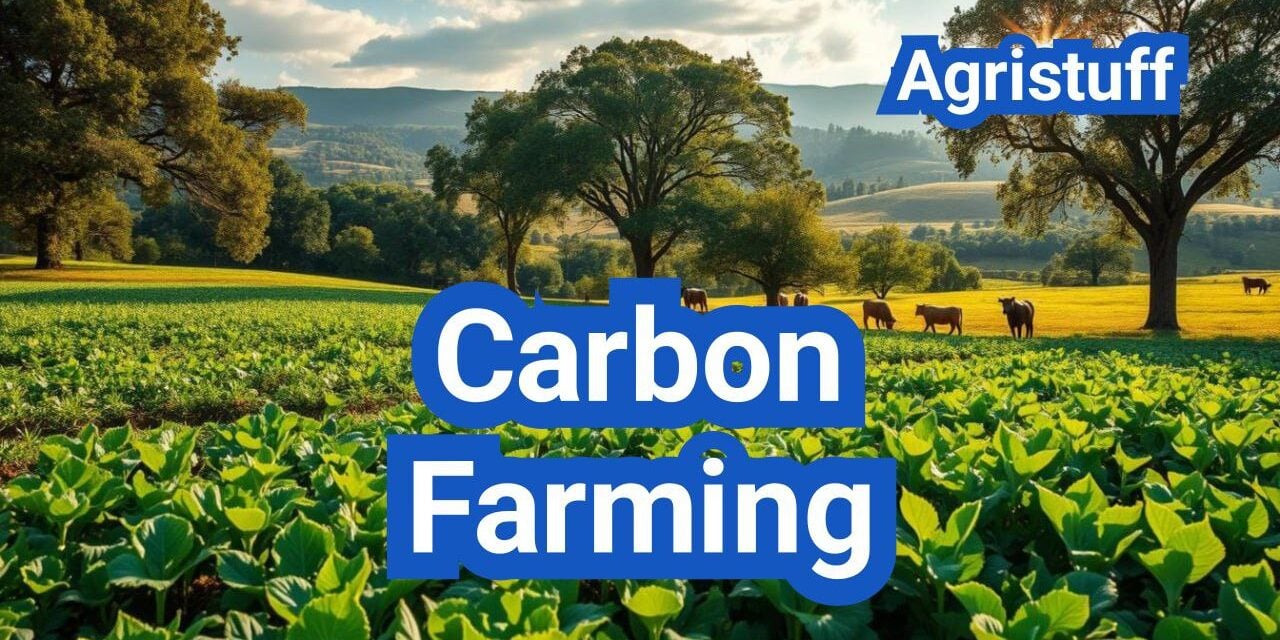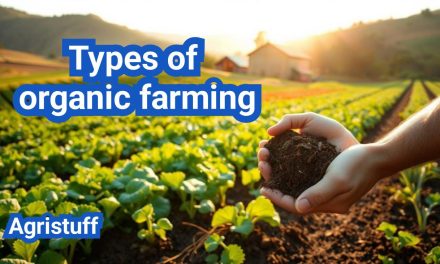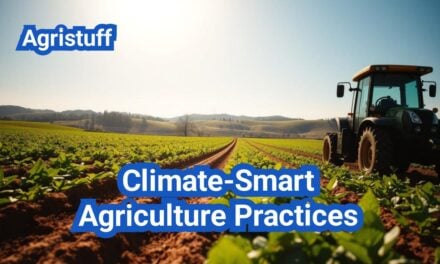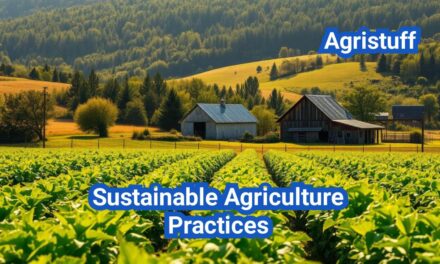Regenerative agriculture is gaining traction among U.S. growers as a viable method to sequester carbon dioxide from the atmosphere into the soil, thereby reducing greenhouse gas emissions.
By adopting practices that promote soil carbon sequestration, farmers can not only contribute to a more sustainable environment but also benefit from various programs and payments designed to support their efforts.
Carbon farming initiatives offer a range of benefits, including the potential to generate carbon credits that can be traded on the market, providing an additional income stream for farmers.
Key Takeaways
- Regenerative agriculture practices can help sequester carbon dioxide from the atmosphere.
- Soil carbon sequestration is a key component of carbon farming initiatives.
- U.S. growers can benefit from various programs and payments supporting sustainable agriculture.
- Carbon credits can be generated and traded on the market.
- Carbon farming promotes sustainable agriculture practices.
Understanding Carbon Farming: A Whole Farm Approach
Carbon farming represents a holistic approach to agriculture, focusing on the integration of various practices to enhance carbon sequestration across the entire farm. This methodology not only aims to mitigate climate change but also promotes sustainable agricultural practices that enhance soil health, biodiversity, and ecosystem services.
The Science Behind Soil Carbon Sequestration
Soil carbon sequestration is the process of transferring carbon dioxide from the atmosphere into the soil through various agricultural practices. It is a critical component of carbon farming, as soils have the potential to act as significant carbon sinks. The science behind this process involves understanding how different farming practices influence soil carbon dynamics. Practices such as reducing tillage, incorporating cover crops, and applying organic amendments can enhance soil organic carbon, improving soil health and fertility.
Research has shown that soil carbon sequestration can be significantly enhanced through the adoption of conservation tillage, cover cropping, and integrated nutrient management. These practices not only contribute to carbon sequestration but also improve soil water retention, reduce erosion, and promote biodiversity.
Agricultural Practices that Enhance Carbon Capture
Agricultural practices play a crucial role in enhancing carbon capture. Techniques such as no-till or reduced-till farming, cover cropping, and diversified crop rotations are effective in promoting soil carbon sequestration. Additionally, integrating livestock into farming systems through practices like rotational grazing can further enhance carbon capture.
Other practices that contribute to carbon capture include agroforestry, where trees are integrated into agricultural landscapes, and the use of organic amendments, which can improve soil health and fertility.
“By adopting a combination of these practices, farmers can not only enhance carbon sequestration but also improve the overall resilience and productivity of their farming systems.”
- No-till or reduced-till farming
- Cover cropping
- Diversified crop rotations
- Rotational grazing
- Agroforestry
Environmental Benefits of Carbon Farming Practices

By implementing carbon farming practices, farmers can contribute to a healthier environment in several key ways. Carbon farming encompasses a range of agricultural methods that enhance carbon sequestration, reduce greenhouse gas emissions, and promote ecosystem services.
Climate Change Mitigation Potential
One of the most significant environmental benefits of carbon farming is its potential for climate change mitigation. By adopting practices such as no-till or reduced-till farming, cover cropping, and integrating organic amendments, farmers can significantly reduce their carbon footprint. These practices not only sequester carbon in soils but also reduce the emissions associated with agricultural production.
- Reduced synthetic fertilizer use lowers nitrous oxide emissions.
- Increased soil organic matter enhances carbon sequestration.
- Improved soil health promotes water retention and reduces erosion.
Soil Health and Water Retention Improvements
Carbon farming practices are closely linked to improvements in soil health. By increasing soil organic matter through the incorporation of cover crops and reducing tillage, soils become more resilient and better equipped to retain water. This not only aids in drought mitigation but also reduces the need for irrigation, conserving water resources.
The benefits to soil health are multifaceted:
- Enhanced structure and porosity improve water infiltration.
- Increased organic matter supports a diverse soil biota.
- Better nutrient cycling reduces the need for external inputs.
Biodiversity and Ecosystem Services
Carbon farming practices also contribute to enhanced biodiversity and ecosystem services. By creating more diverse and complex agricultural landscapes, farmers can support a wider range of plant and animal species. This biodiversity is crucial for maintaining ecosystem resilience and ensuring the long-term productivity of agricultural systems.
The ecosystem services provided by carbon farming include:
- Pollinator support through diverse flowering plants.
- Habitat creation for beneficial insects and wildlife.
- Improved nutrient cycling and soil health.
In conclusion, the environmental benefits of carbon farming practices are substantial, ranging from climate change mitigation to improvements in soil health, water retention, and biodiversity. As the agricultural sector continues to evolve, the adoption of these practices will play a critical role in creating a more sustainable food system.
Economic Incentives for U.S. Growers
Carbon farming is not just environmentally friendly; it also provides substantial economic incentives for U.S. growers. By adopting sustainable agricultural practices, farmers can open up new revenue streams and improve their bottom line.
Carbon Credit Markets Explained
One of the primary economic incentives for U.S. growers is the opportunity to participate in carbon credit markets. By implementing practices that sequester carbon or reduce greenhouse gas emissions, farmers can earn carbon credits, which can then be sold to companies looking to offset their emissions.
“The carbon credit market represents a significant opportunity for farmers to monetize their environmental stewardship,” according to a recent report on sustainable agriculture.
- Carbon credits are generated based on the amount of carbon sequestered or emissions reduced.
- These credits are then verified by third-party auditors to ensure their validity.
- Farmers can sell their credits on carbon markets, providing a new source of income.
Reduced Input Costs and Yield Benefits
Adopting carbon farming practices can also lead to reduced input costs and improved yields. Practices such as no-till or reduced-till farming, cover cropping, and integrated livestock grazing can enhance soil health, reduce erosion, and improve water retention.
These practices not only contribute to environmental sustainability but also make farming operations more efficient and resilient. For instance, healthier soils can lead to better nutrient cycling, reducing the need for synthetic fertilizers.
| Practice | Potential Benefits |
|---|---|
| No-till or Reduced-till | Reduced erosion, improved soil health |
| Cover Cropping | Enhanced soil fertility, reduced input costs |
| Integrated Livestock Grazing | Improved soil carbon, increased biodiversity |
Risk Mitigation and Resilience Value
Carbon farming practices can also provide risk mitigation and resilience value. By improving soil health and water retention, farmers can better withstand droughts and other climate-related stressors.
Moreover, diversifying farm operations through practices like agroforestry or integrating multiple crops can reduce dependence on a single commodity, thereby mitigating market risks.
“By adopting carbon farming practices, farmers not only contribute to mitigating climate change but also enhance their farm’s resilience to its impacts.”
In conclusion, the economic incentives for U.S. growers to adopt carbon farming practices are multifaceted, ranging from carbon credit markets to reduced input costs and improved resilience. As the agricultural sector continues to evolve, embracing these practices can position farmers for long-term success.
Core Carbon Farming Methods and Techniques

Effective carbon farming relies on several key methods that work together to sequester carbon in soils and biomass. These practices not only help mitigate climate change but also improve soil health, enhance biodiversity, and promote sustainable agriculture.
Soil Management Fundamentals
Soil management is a critical component of carbon farming. Techniques such as reduced tillage or no-till farming minimize soil disturbance, preserving soil organic matter and reducing erosion. Additionally, practices like cover cropping and incorporating organic amendments enhance soil fertility and structure, promoting carbon sequestration.
Soil testing and monitoring are essential to understanding the soil’s carbon storage potential and identifying areas for improvement. By adopting these soil management fundamentals, farmers can create a more resilient and carbon-rich soil environment.
Crop Selection and Rotation Strategies
Crop selection and rotation play a vital role in carbon farming. By choosing diverse crop rotations that include cover crops, farmers can enhance soil health, reduce pests and diseases, and increase carbon sequestration. Perennial crops, in particular, offer significant benefits due to their extensive root systems and reduced soil disturbance.
Strategic crop selection can also improve soil’s water-holding capacity, reducing the need for irrigation and enhancing drought resilience. Furthermore, incorporating legumes into rotations can fix atmospheric nitrogen, reducing the need for synthetic fertilizers.
Livestock Integration Approaches
Integrating livestock into farming systems can significantly enhance carbon sequestration. Practices such as rotational grazing allow pastures to recover, promoting soil health and carbon storage. By managing grazing intensity and duration, farmers can optimize forage production while minimizing erosion and improving soil organic matter.
Livestock integration also offers opportunities for manure management, which can reduce nitrous oxide emissions and methane losses. By incorporating livestock into carbon farming systems, farmers can create more diverse and resilient agricultural ecosystems.
No-Till and Reduced Tillage Implementation
Implementing no-till and reduced tillage practices is a crucial step towards enhancing soil health and carbon sequestration in agricultural lands. These methods minimize soil disturbance, which is essential for maintaining soil organic matter and reducing erosion.
Getting Started with Conservation Tillage
To begin with conservation tillage, farmers should first assess their soil type and condition. Soil testing is crucial to determine the nutrient content and structure. This information helps in deciding the appropriate tillage method and crop selection.
Another important aspect is understanding the previous crop history and the current soil management practices. This knowledge aids in planning the transition to no-till or reduced tillage effectively.
Equipment Considerations and Modifications
No-till and reduced tillage require specific equipment or modifications to existing machinery. For instance, no-till drills are designed to plant seeds in undisturbed soil, while conservation tillage equipment may involve modifications to reduce soil disturbance.
| Equipment Type | Modification/Feature | Benefit |
|---|---|---|
| No-till Drills | Precision seed placement | Improved seed-to-soil contact |
| Conservation Tillage Equipment | Reduced tine or disc spacing | Minimized soil disturbance |
| Planters | Row cleaners or residue managers | Enhanced seedbed preparation |
Managing Weeds and Residue
Effective weed control is critical in no-till and reduced tillage systems. Herbicide application and cover cropping are common strategies used to manage weeds. Additionally, maintaining adequate crop residue helps suppress weed growth and retains soil moisture.
By adopting no-till and reduced tillage practices, farmers can significantly contribute to carbon sequestration efforts while improving soil health and reducing environmental impact.
Cover Crops for Enhanced Carbon Sequestration

Cover crops are a valuable tool for farmers looking to enhance carbon sequestration and promote regenerative agriculture practices. By incorporating cover crops into their rotation, farmers can not only improve soil health but also contribute to climate change mitigation efforts.
Selecting the Right Cover Crop Species
The selection of appropriate cover crop species is crucial for maximizing carbon sequestration benefits. Different species offer varying levels of carbon input, nitrogen fixation, and soil protection. Some of the most effective cover crops for carbon sequestration include:
- Legumes (e.g., clover, beans): These crops fix atmospheric nitrogen, reducing the need for synthetic fertilizers and promoting soil health.
- Grasses (e.g., rye, oats): Grasses provide extensive root systems that help to stabilize soil and increase carbon storage.
- Brassicas (e.g., radish, turnip): These crops can help to break up compacted soil and improve soil structure, enhancing water infiltration and aeration.
Establishment and Termination Techniques
Successful integration of cover crops into a farming system depends on effective establishment and termination techniques. Proper seeding rates, timing, and methods are critical for ensuring good stand establishment. Termination techniques, such as mowing, rolling, or herbicide application, must be timed appropriately to avoid interfering with the subsequent cash crop.
Some key considerations for establishment and termination include:
- Seeding Rate and Depth: Adjusting seeding rates and depths according to the specific cover crop species and soil conditions.
- Termination Timing: Terminating cover crops at the optimal stage to maximize biomass production and minimize regrowth.
Measuring Cover Crop Benefits
To understand the impact of cover crops on carbon sequestration, it’s essential to measure their benefits accurately. This involves monitoring changes in soil organic carbon, assessing the biomass production of cover crops, and evaluating the overall ecosystem services provided.
Farmers can use various tools and techniques to measure these benefits, including:
- Soil testing to determine changes in soil organic carbon and other nutrients.
- Biomass sampling to estimate the carbon input from cover crops.
- Ecosystem service assessments to evaluate the broader environmental benefits of cover cropping.
Adaptive Grazing Management Systems

The implementation of adaptive grazing management systems represents a significant shift towards more regenerative and sustainable agricultural practices. These systems focus on optimizing the health and productivity of pastures through careful management of grazing patterns.
Rotational Grazing Implementation
Rotational grazing is a key component of adaptive grazing management. By dividing pastures into smaller sections and rotating livestock through them, farmers can prevent overgrazing and allow vegetation to recover. This approach not only improves pasture health but also increases biodiversity and enhances ecosystem services.
The benefits of rotational grazing include improved soil health, increased water retention, and enhanced carbon sequestration. By managing grazing patterns effectively, farmers can create a more resilient and productive agricultural system.
Monitoring Pasture Health and Recovery
Effective adaptive grazing management requires continuous monitoring of pasture health. This involves assessing vegetation cover, soil condition, and the presence of indicators such as certain plant species or signs of erosion. By monitoring these factors, farmers can make informed decisions about grazing patterns and adjust their management strategies as needed.
| Indicator | Healthy Pasture | Degraded Pasture |
|---|---|---|
| Vegetation Cover | >70% | |
| Soil Erosion | Minimal | Significant |
| Biodiversity | High | Low |
Carbon Benefits of Well-Managed Grazing
Well-managed grazing practices can significantly contribute to carbon sequestration efforts. By improving soil health and increasing vegetation cover, adaptive grazing management systems can enhance the carbon storage potential of pastures. Studies have shown that rotational grazing can lead to increased soil organic carbon, reduced greenhouse gas emissions, and improved overall ecosystem health.
Key benefits of adaptive grazing management include:
- Increased carbon sequestration
- Improved soil health
- Enhanced biodiversity
- Better water retention
Agroforestry and Silvopasture Opportunities

Integrating trees into agricultural landscapes through agroforestry and silvopasture offers multiple benefits for farmers and the environment. These practices not only enhance carbon sequestration but also improve biodiversity, soil health, and farm productivity.
Tree Integration Models for Different Regions
Agroforestry involves the intentional integration of trees into agricultural landscapes to enhance productivity and ecological interactions. Different regions can adopt various tree integration models based on climate, soil type, and existing land use.
- Alley Cropping: Planting crops between rows of trees to enhance soil health and reduce erosion.
- Windbreaks: Strategically planting trees to block winds, reducing soil erosion and protecting crops.
- Riparian Buffer Strips: Planting trees and vegetation along water bodies to improve water quality and reduce sedimentation.
Species Selection for Maximum Carbon Benefit
The choice of tree species is critical in agroforestry and silvopasture systems for maximizing carbon sequestration. Factors such as growth rate, longevity, and wood density influence the carbon storage potential of trees.
- Nitrogen-fixing trees like black locust and alder can enhance soil fertility.
- Fast-growing trees such as poplar and willow can quickly sequester carbon.
- Long-lived trees like oak and beech provide long-term carbon storage.
Economic Diversification Through Woody Crops
Agroforestry and silvopasture not only contribute to environmental sustainability but also offer opportunities for economic diversification. By integrating woody crops into their operations, farmers can generate additional income streams.
- Producing timber and non-timber forest products.
- Engaging in agroforestry tourism.
- Selling carbon credits from well-managed agroforestry systems.
By adopting agroforestry and silvopasture practices, farmers can enhance their resilience to climate change, improve their environmental footprint, and diversify their income sources.
Nitrous Oxide Reduction Strategies

The agricultural sector can contribute to climate change mitigation by adopting nitrous oxide reduction methods, including precision farming and alternative nitrogen sources. Nitrous oxide (N2O) is a potent greenhouse gas, with a global warming potential significantly higher than CO2. Agricultural activities are a major source of N2O emissions, primarily due to the use of nitrogen-based fertilizers.
Precision Fertilizer Application Methods
Precision fertilizer application involves using advanced technology to optimize fertilizer use, reducing excess nitrogen that can lead to N2O emissions. Techniques include GPS-guided equipment, soil testing, and crop monitoring. By applying fertilizers more precisely, farmers can minimize waste and reduce environmental impact.
Timing and Placement Optimization
Optimizing the timing and placement of fertilizer application can significantly reduce N2O emissions. Applying fertilizers during the growing season when crops can most effectively utilize the nutrients reduces the likelihood of nitrogen loss. Additionally, placing fertilizers in the root zone rather than broadcasting them on the surface can enhance uptake efficiency.
Alternative Nitrogen Sources
Exploring alternative nitrogen sources is another strategy for reducing N2O emissions. Options include using organic amendments like manure or compost, legume crops that fix atmospheric nitrogen, and synthetic nitrogen fertilizers with slow-release or nitrification inhibitors. These alternatives can reduce the need for conventional nitrogen fertilizers.
| Strategy | Description | Potential N2O Reduction |
|---|---|---|
| Precision Fertilizer Application | Using technology to optimize fertilizer use | Up to 20% |
| Timing and Placement Optimization | Applying fertilizers at the right time and place | 15-30% |
| Alternative Nitrogen Sources | Using organic or slow-release nitrogen sources | 10-25% |
Implementing these nitrous oxide reduction strategies not only contributes to climate change mitigation but can also improve farm profitability and sustainability. By adopting precision agriculture techniques, optimizing fertilizer application, and exploring alternative nitrogen sources, farmers can play a crucial role in reducing agricultural greenhouse gas emissions.
Manure Methane Mitigation Techniques

Agricultural producers can significantly reduce their carbon footprint by implementing manure methane mitigation techniques. Manure management plays a critical role in minimizing greenhouse gas emissions from farming operations.
Storage and Treatment Innovations
Innovative storage and treatment methods are being developed to reduce methane emissions from manure. One such approach is the use of covered lagoons, which can significantly decrease methane production.
According to the USDA, “Covered lagoons can reduce methane emissions by capturing the gas for energy production or flaring it off.” This approach not only reduces emissions but also provides an opportunity for energy generation.
| Storage Method | Methane Reduction Potential | Additional Benefits |
|---|---|---|
| Covered Lagoons | High | Energy production, odor reduction |
| Open Lagoons | Low | Low infrastructure costs |
| Deep Pit Storage | Medium | Easy manure handling |
Biogas Capture and Utilization
Biogas capture is another effective method for reducing methane emissions. By capturing biogas, farmers can produce renewable energy and reduce their reliance on fossil fuels.
Biogas utilization can take many forms, including electricity generation, heat production, and even fuel for vehicles. The benefits of biogas capture are multifaceted, contributing to both environmental sustainability and economic viability.
“Biogas production from manure can provide a significant source of renewable energy while reducing greenhouse gas emissions.”
— EPA
Composting Systems for Reduced Emissions
Composting is a valuable manure management strategy that can significantly reduce methane emissions. By composting manure, farmers can create a valuable product for soil health while minimizing environmental impact.
The key to effective composting is maintaining aerobic conditions, which can be achieved through regular turning and monitoring of the compost pile. Proper composting techniques can reduce methane emissions and produce a stable, nutrient-rich product.
Low-Carbon Biofuel Feedstock Production

Low-carbon biofuel feedstocks represent a significant opportunity for U.S. growers to diversify their operations and contribute to a more sustainable energy future. The production of these feedstocks involves growing sustainable biomass crops that can be seamlessly integrated into existing farm operations.
Sustainable Biomass Crop Options
Several crops are well-suited for low-carbon biofuel production, including:
- Corn stover: a residue from corn production that can be harvested without compromising grain yields
- Switchgrass: a perennial grass native to North America, known for its high biomass production and low input requirements
- Miscanthus: a highly productive grass that can thrive on marginal lands
- Energy cane: a type of sugarcane bred for its high biomass production potential
These crops offer not only a potential new revenue stream for farmers but also contribute to soil health and biodiversity.
Integration with Existing Farm Operations
Integrating biofuel crops into existing operations requires careful planning. Farmers can:
- Rotate biofuel crops with traditional crops to enhance soil health and reduce pest pressure
- Utilize marginal lands for biofuel crop production, improving land use efficiency
- Adopt conservation tillage practices to reduce erosion and improve soil carbon sequestration
This integration can lead to improved overall farm resilience and reduced environmental impact.
Market Opportunities for Biofuel Crops
The market for low-carbon biofuel feedstocks is expanding, driven by policies and regulations aimed at reducing carbon emissions. Farmers can benefit from:
- Long-term contracts with biofuel producers, providing income stability
- Premium prices for sustainable biomass, enhancing profitability
- Access to new markets and revenue streams, diversifying farm income
As the demand for low-carbon biofuels continues to grow, the opportunities for U.S. farmers to participate in this market are likely to increase.
Federal Carbon Farming Programs and Incentives

Carbon farming is becoming increasingly important, with federal programs leading the way. The United States Department of Agriculture (USDA) has introduced several initiatives to support growers in adopting climate-smart agriculture practices.
USDA Climate-Smart Agriculture Initiatives
The USDA’s Climate-Smart Agriculture initiatives aim to reduce greenhouse gas emissions while promoting agricultural productivity. Key programs include:
- Climate-Smart Commodities: This program provides financial incentives to producers who adopt climate-smart practices.
- Partnerships for Climate-Smart Commodities: The USDA partners with various organizations to promote and implement climate-smart commodity production.
Conservation Program Opportunities
Several conservation programs offered by the USDA can support carbon farming practices. These include:
- Conservation Stewardship Program (CSP): CSP provides financial and technical assistance to producers who maintain and improve existing conservation practices.
- Environmental Quality Incentives Program (EQIP): EQIP offers financial assistance to farmers and ranchers who implement conservation practices, including those that enhance carbon sequestration.
Application Processes and Eligibility Requirements
To benefit from these programs, growers must understand the application processes and eligibility requirements. Generally, applications are submitted through the USDA’s local offices or online portals. Eligibility often depends on factors such as:
- Farm or ranch size: Some programs have specific limits on the size of operations that can participate.
- Conservation practice adoption: Producers are often required to implement specific conservation practices to be eligible.
- Compliance with program rules: Applicants must adhere to program guidelines and requirements.
It’s essential for growers to review the specific requirements for each program and seek assistance from USDA representatives if needed.
State-Level Support for Carbon Farming
The importance of state-level initiatives in promoting carbon farming cannot be overstated, as they provide critical support to farmers adopting climate-friendly practices. Many states have recognized the potential of carbon farming to mitigate climate change while enhancing agricultural productivity and sustainability.
Leading State Programs and Incentives
Several states have taken the lead in developing programs and incentives to support carbon farming. For instance:
- California’s Healthy Soils Program: Offers grants to farmers who implement practices that improve soil health and sequester carbon.
- Illinois’ Soil Health Initiative: Provides technical assistance and financial incentives to farmers adopting conservation tillage and cover cropping.
- Minnesota’s Soil Health Program: Supports farmers in adopting practices that enhance soil health through grants and technical assistance.
Regional Partnerships and Resources
Beyond state-level programs, regional partnerships play a crucial role in supporting carbon farming. These partnerships often bring together farmers, researchers, and policymakers to share knowledge, resources, and best practices. For example:
- The Midwest Cover Crops Council provides resources and guidance on cover cropping practices.
- The Western Cover Crops Council supports the adoption of cover crops in western states.
Combining Federal and State Benefits
One of the key advantages for farmers is the ability to combine federal and state benefits. By leveraging both federal programs like the USDA’s Climate-Smart Agriculture initiatives and state-level incentives, farmers can maximize their support. For instance, a farmer in Illinois could participate in the USDA’s Environmental Quality Incentives Program (EQIP) while also receiving funding through the Illinois Soil Health Initiative.
To effectively combine these benefits, farmers should:
- Consult with local agricultural extension offices to understand available programs.
- Review eligibility criteria for both federal and state programs.
- Develop a comprehensive plan that integrates practices supported by both levels of government.
Carbon Credit Verification Process
As carbon farming gains traction, understanding the verification process for carbon credits becomes increasingly important. The verification process is crucial for ensuring that carbon farming practices achieve their intended environmental benefits.
Understanding Baseline Assessments
Baseline assessments are a fundamental component of the carbon credit verification process. They involve establishing a reference point against which future carbon sequestration or reduction can be measured. Accurate baseline assessments are essential for verifying the effectiveness of carbon farming practices.
The process typically involves collecting data on existing farming practices, soil types, and environmental conditions. This information helps in determining the baseline carbon stock and predicting future changes.
GHG Protocol Agricultural Standards
The Greenhouse Gas Protocol (GHG Protocol) provides critical standards for quantifying and verifying greenhouse gas emissions and removals. For agricultural projects, the GHG Protocol Agricultural Guidance is particularly relevant. It offers a framework for measuring and reporting GHG emissions and sequestration related to agricultural practices.
Adhering to GHG Protocol standards ensures that carbon credit claims are credible and based on robust data. This involves using approved methodologies for estimating GHG emissions and removals.
ISO 14064 Verification Requirements
ISO 14064 is an international standard that provides a framework for quantifying, reporting, and verifying GHG emissions and removals. For carbon credit verification, ISO 14064-1 is particularly relevant as it specifies requirements for designing, developing, and managing GHG inventories.
Verification against ISO 14064 standards involves an independent audit to ensure that GHG data is accurate and reliable. This process enhances the credibility of carbon credits by demonstrating compliance with internationally recognized standards.
By understanding and adhering to these verification requirements, U.S. growers can effectively participate in carbon credit markets and contribute to global efforts to mitigate climate change.
Using COMET-Farm and Other Modeling Tools
Carbon farming initiatives can be optimized through the use of advanced modeling tools like COMET-Farm, which help in assessing carbon sequestration potential. These tools are essential for farmers and agricultural practitioners to quantify their carbon footprint and make informed decisions.
Step-by-Step Guide to COMET-Farm Assessment
COMET-Farm is a user-friendly tool designed to help farmers assess their carbon sequestration and emissions reductions. Here’s a step-by-step guide to using COMET-Farm:
- Step 1: Gather necessary farm data, including soil type, crop rotation, and management practices.
- Step 2: Input the data into the COMET-Farm platform, following the on-screen instructions.
- Step 3: Review the generated report, which will provide insights into your farm’s carbon sequestration potential.
- Step 4: Use the results to identify areas for improvement and adjust your management practices accordingly.
Alternative Carbon Calculation Tools
While COMET-Farm is a robust tool, there are other carbon calculation tools available that can complement its functionality. Some of these include:
- Carbon Footprint Calculator: A tool that helps farmers calculate their overall carbon footprint.
- Agroforestry Carbon Assessment Tool: Useful for assessing carbon sequestration in agroforestry systems.
- Soil Carbon Management Tool: Focuses on optimizing soil carbon levels through best management practices.
Interpreting Results and Making Management Decisions
Interpreting the results from carbon calculation tools is crucial for making informed management decisions. Here are some key considerations:
- Understand the metrics: Familiarize yourself with the metrics used in the report, such as tons of CO2 equivalent per acre.
- Identify areas for improvement: Look for practices that can be adjusted to enhance carbon sequestration.
- Develop a management plan: Based on the results, create a plan to implement changes that will improve your farm’s carbon footprint.
By leveraging tools like COMET-Farm and other carbon calculation tools, farmers can make data-driven decisions to optimize their carbon farming practices, contributing to a more sustainable agricultural future.
Overcoming Implementation Challenges
To successfully implement carbon farming, growers must navigate several significant challenges. While carbon farming offers numerous benefits, its adoption is often hindered by financial, technical, and infrastructural barriers.
Financial Barriers and Funding Solutions
One of the primary challenges to implementing carbon farming practices is the initial financial investment required. Transitioning to new practices and technologies can be costly. However, various funding solutions and incentives are available to help mitigate these expenses.
Funding Opportunities:
- Government grants and subsidies
- Private investment in carbon credits
- Low-interest loans for sustainable agriculture
| Funding Source | Description | Eligibility |
|---|---|---|
| USDA Climate-Smart Agriculture Initiatives | Grants for implementing climate-smart practices | Farmers and ranchers adopting climate-smart agriculture |
| Carbon Credit Programs | Financial incentives for reducing carbon emissions | Projects that demonstrate measurable carbon reduction |
| Sustainable Agriculture Loans | Low-interest loans for sustainable practices | Farmers transitioning to sustainable agriculture methods |
Technical Knowledge Gaps and Resources
Adopting carbon farming practices often requires specialized knowledge and technical expertise. To address this challenge, various resources are available to provide training and support.
Key Resources:
- Extension services and workshops
- Online training platforms
- Consulting services for carbon farming
Equipment and Infrastructure Considerations
The transition to carbon farming may necessitate changes in equipment and infrastructure. While this can be a significant upfront cost, it often leads to long-term savings and efficiency improvements.
Equipment Considerations:
- No-till or reduced-till drills
- Cover crop seeders
- Precision agriculture technology
By understanding and addressing these challenges, growers can more effectively implement carbon farming practices, contributing to a more sustainable agricultural future.
The Future of Carbon Farming in U.S. Agriculture
Carbon farming has emerged as a vital strategy for U.S. agriculture, offering a promising path towards mitigating climate change while supporting sustainable farming practices. As the agricultural sector continues to evolve, the integration of carbon farming methods is expected to play a significant role in reducing greenhouse gas emissions and enhancing soil health.
The future of carbon farming in U.S. agriculture looks bright, with various federal and state programs providing incentives for growers to adopt climate-resilient practices. By leveraging these programs and incorporating techniques such as no-till farming, cover cropping, and adaptive grazing management, farmers can not only contribute to climate change mitigation but also improve their bottom line through reduced input costs and increased yields.
As the demand for climate-friendly agricultural products grows, the role of carbon farming in U.S. agriculture will continue to expand. By embracing this approach, farmers, policymakers, and consumers can work together to create a more sustainable food system that benefits both the environment and the economy.
FAQ
What is carbon farming?
Carbon farming is a whole farm approach that involves implementing agricultural practices that enhance carbon capture and reduce greenhouse gas emissions.
What are the benefits of carbon farming?
The benefits of carbon farming include climate change mitigation, improved soil health, enhanced biodiversity, and economic incentives for farmers through carbon credit markets.
How does soil carbon sequestration work?
Soil carbon sequestration involves using agricultural practices like no-till or reduced tillage, cover cropping, and organic amendments to increase the amount of carbon stored in soils.
What are the most effective agricultural practices for carbon farming?
Effective practices include no-till or reduced tillage, cover cropping, crop rotation, agroforestry, and adaptive grazing management.
How can farmers get started with carbon farming?
Farmers can start by assessing their current practices, identifying opportunities for improvement, and implementing new techniques like conservation tillage or cover cropping.
What is the role of cover crops in carbon farming?
Cover crops help enhance carbon sequestration by adding organic matter to soils, reducing erosion, and promoting soil health.
How do carbon credit markets work?
Carbon credit markets allow farmers to generate credits by implementing carbon-reducing practices, which can then be sold to offset emissions elsewhere.
What are the challenges to implementing carbon farming?
Challenges include financial barriers, technical knowledge gaps, and equipment considerations, as well as policy and regulatory uncertainty.
How can farmers verify their carbon credits?
Verification involves using standards like the GHG Protocol Agricultural Standards and ISO 14064, and tools like COMET-Farm to quantify carbon reductions.
What is the future of carbon farming in U.S. agriculture?
Carbon farming is poised to play a significant role in U.S. agriculture, offering a pathway to climate change mitigation, sustainable agricultural practices, and economic benefits for farmers.
Are there any federal programs supporting carbon farming?
Yes, the USDA offers various initiatives and conservation programs that support carbon farming, including the Climate-Smart Agriculture initiative.
Can farmers combine federal and state benefits for carbon farming?
Yes, farmers can often combine federal and state benefits, and should explore regional partnerships and resources to maximize their incentives.
How does adaptive grazing management contribute to carbon farming?
Adaptive grazing management, including rotational grazing, can enhance carbon sequestration by promoting soil health, improving pasture recovery, and reducing erosion.
What are the opportunities for agroforestry and silvopasture in carbon farming?
Agroforestry and silvopasture offer opportunities for integrating trees into farming systems, enhancing biodiversity, and promoting carbon sequestration, while also providing economic diversification.
Conclusion of: Carbon Farming
What carbon farming means—and why it matters now
Carbon farming is the set of on-farm practices that reduce greenhouse gas emissions or increase carbon storage in soils and biomass, turning stewardship into a revenue stream while supporting soil health, water retention, and resilience. For U.S. producers, carbon farming aligns with fast-evolving markets, tax credits, and federal cost-share opportunities that reward measurable outcomes in cropland, rangeland, and forestry. Understanding how carbon farming connects to U.S. emissions accounting and land-based “sinks” is the first step toward choosing the right program and getting paid. (EPA: U.S. GHG Inventory)
Which practices count as carbon farming?
In most programs, carbon farming covers improvements like no-till or strip-till, diverse cover crops, nutrient management with 4R stewardship, rotational or adaptive grazing, manure handling upgrades (e.g., separators, digesters), windbreaks, riparian buffers, and agroforestry. These practices either cut nitrous oxide and methane or increase soil organic carbon—often the core metric in carbon farming contracts. Eligible practice lists are expanding as science advances, so always confirm what your target program recognizes before you enroll. (NRCS: Climate-Smart Mitigation Activities) :contentReference[oaicite:0]{index=0}
Three pathways to monetize carbon farming
Today, U.S. growers typically get paid for carbon farming via: (1) federal conservation cost-share and stewardship programs, (2) private voluntary carbon markets that issue tradable credits, and (3) low-carbon supply-chain programs (e.g., biofuels or branded food) that reward lower life-cycle emissions. Each pathway values carbon farming differently—per acre, per practice, per verified ton, or per unit of low-carbon commodity—so match your operation’s data strength and risk tolerance to the payment logic. (USDA: Climate Solutions overview) :contentReference[oaicite:1]{index=1}
Federal cost-share for carbon farming: EQIP
The Environmental Quality Incentives Program (EQIP) helps fund carbon farming practices through up-front planning and cost-share for implementation. Payment rates vary by practice and state; historically underserved producers may qualify for advance payments to reduce out-of-pocket costs. EQIP is often the fastest on-ramp to finance conservation that later feeds data into crediting or supply-chain programs. (NRCS: EQIP) :contentReference[oaicite:2]{index=2}
Federal stewardship payments for carbon farming: CSP
The Conservation Stewardship Program (CSP) pays annually to maintain and enhance conservation performance, which can include carbon farming enhancements like cover-crop diversity, residue management, or precision nutrient application. As of FY2024, USDA increased CSP’s minimum annual payment, improving economics for smaller and underserved operations that commit to multi-year stewardship. (NRCS: CSP Minimum Payment Update) :contentReference[oaicite:3]{index=3}
IRA dollars turbocharge carbon farming adoption
The Inflation Reduction Act invested billions into climate-smart agriculture—funding NRCS programs that directly support carbon farming adoption and verification capacity nationwide. For many producers, that means more opportunities, larger signups, and improved technical assistance for emissions-cutting practices. (NRCS: CSAF & IRA factsheet (PDF)) :contentReference[oaicite:4]{index=4}
“Climate-Smart Commodities” grants and carbon farming
USDA’s Partnerships for Climate-Smart Commodities fund projects that pay producers to adopt carbon farming practices and measure results, often using USDA-aligned tools and third-party partners. If a project covers your state and crop, you may be able to stack climate-smart payments with traditional conservation support while generating high-quality data for future crediting. (USDA: Project Summaries) :contentReference[oaicite:5]{index=5}
How private carbon markets frame carbon farming
Voluntary carbon programs treat carbon farming as a project that must demonstrate additionality (beyond the baseline), durability, and measurable net climate benefit before issuing credits. USDA’s recent report to Congress outlines how agriculture can participate in these markets and why measurement, monitoring, reporting, and verification (MMRV) underpins credit quality and buyer confidence. (USDA: Assessment of Ag & Forestry in U.S. Carbon Markets (PDF)) :contentReference[oaicite:6]{index=6}
Registries and protocols that recognize carbon farming
To issue tradable credits, carbon farming projects typically register under a standard with approved methodologies—e.g., soil enrichment or improved cropland management. Leading registries and standards publish the rules for baselines, sampling, modeling, leakage, reversals, and verification so growers understand what “counts.” Review at least one relevant protocol before you sign. (Climate Action Reserve: Soil Enrichment Protocol) :contentReference[oaicite:7]{index=7}
How payments work for carbon farming
Programs may pay per acre for specific practices (e.g., $/ac for cover crops) or per verified ton of CO2e reduced or removed (e.g., $/t from soil carbon gains). Surveys suggest many row-crop producers view per-acre offers under about $30 as insufficient, reflecting both risk and record-keeping burden in carbon farming. Always check whether rates are introductory, fixed, or performance-based. (Purdue Ag Economy Barometer) :contentReference[oaicite:8]{index=8}
Can you “stack” carbon farming payments?
Some programs let you combine federal conservation payments with private carbon farming contracts, but you must avoid “double counting” the same outcome toward multiple credits. Also plan for taxes: NRCS payments are typically reported to the IRS, and you’ll receive a 1099; talk to your tax advisor about soil and water conservation deductions and your specific carbon farming income. (NRCS: CSP FAQ on Payments & 1099s (PDF)) :contentReference[oaicite:9]{index=9}
MRV: the data backbone of carbon farming
Measurement, reporting, and verification (MRV) for carbon farming often combines activity data (planting/harvest dates, seed/variety, fertilizer rates, tillage), models calibrated to USDA science, and—when required—soil sampling. Many U.S. projects rely on COMET-Farm/COMET-Planner modeling and USDA’s entity-scale methods to quantify changes with transparency. Store field-level records now to avoid retroactive headaches later. (USDA OCE: GHG Tools (COMET)) :contentReference[oaicite:10]{index=10}
Independent verification in carbon farming
High-quality carbon farming credits are typically validated and verified by accredited third parties against recognized standards. In the U.S., bodies accredited under ISO 14065 use ISO 14064-3 procedures to verify that your MRV and calculations are accurate before issuance on a registry—an important safeguard for credit buyers and grower reputations. (ANAB: GHG Validation & Verification) :contentReference[oaicite:11]{index=11}
Accounting rules that touch carbon farming results
Downstream buyers (fuel producers, food brands) increasingly follow the GHG Protocol’s Land Sector & Removals guidance to account for agriculture emissions and removals credibly. If a supply-chain program buys your carbon farming outcomes, expect its rules to align with this framework to prevent double counting and ensure consistent reporting. (GHG Protocol: Land Sector & Removals) :contentReference[oaicite:12]{index=12}
Biofuels & 45Z: a new demand signal for carbon farming
Beginning in 2025, the federal §45Z Clean Fuel Production Credit rewards fuels with lower life-cycle carbon intensity—potentially channeling value back to growers whose carbon farming reduces feedstock footprints (e.g., low-CI corn for ethanol). Treasury and DOE require the 45ZCF-GREET model to calculate fuel CI, so data from your carbon farming may help your buyers claim the credit. (IRS: Clean Fuel Production Credit) :contentReference[oaicite:13]{index=13}
Practice-by-practice notes for carbon farming
No-till/strip-till in carbon farming lowers fuel and preserves aggregates; multi-species cover crops increase residue inputs; 4R nutrient stewardship cuts nitrous oxide; improved manure handling or digesters reduce methane; and managed grazing boosts below-ground biomass. Choose a practice stack that improves profitability and builds durable carbon gains that MRV systems can track. (EPA: Agriculture Sector Emissions) :contentReference[oaicite:14]{index=14}
Contracts: what to read twice in carbon farming deals
Before you enroll in carbon farming, scrutinize permanence or monitoring periods (often 5–20+ years), reversal risk and buffer pools, data ownership, audit rights, switching crops, landlord/tenant obligations, and who controls credits vs. environmental attributes. USDA’s assessment lays out why clarity on baselines, boundaries, and leakage matters for credible outcomes. (USDA: Carbon Markets Assessment (PDF)) :contentReference[oaicite:15]{index=15}
Enrollment checklist to start carbon farming
Map fields, list current practices, gather three years of records, identify agronomic advisors, and confirm state EQIP/CSP sign-ups. Then, short-list one market program and one supply-chain buyer. If you’re new to USDA, book time at your local Service Center; they’ll help you align conservation planning with the carbon farming path you choose. (Find Your USDA Service Center) :contentReference[oaicite:16]{index=16}
Verification & issuance pathways for carbon farming credits
If crediting makes sense, match your practice and region to a registry methodology (e.g., soil enrichment or cropland management), confirm sampling/modeling requirements, and price third-party verification. Many U.S. projects reference protocols from registries such as Verra, the Climate Action Reserve, or Gold Standard; review them to understand data burdens before committing carbon farming acres. (Verra: Methodologies) :contentReference[oaicite:17]{index=17}
Data quality tips to strengthen carbon farming claims
In carbon farming, small data gaps can snowball into big uncertainty. Log seed brand and planting dates; fertilizer sources, rates, and placements; tillage passes; grazing days and stocking rates; manure volumes; irrigation; and yields. Align your record-keeping with the fields asked by COMET-Farm or your program’s MRV tool to minimize verification back-and-forth. (USDA OCE: COMET & Methods) :contentReference[oaicite:18]{index=18}
Risk management: carbon farming and reversals
Soil carbon can decline with severe drought, tillage, or land conversion. Crediting programs handle this “reversal risk” via buffer accounts and ongoing practice commitments; if permanence is a stretch, consider practice-based or supply-chain programs that value carbon farming without long-term liability. (CAR: Soil Enrichment Protocol) :contentReference[oaicite:19]{index=19}
Where carbon farming is headed (near term)
Expect more consistent accounting across buyers as GHG Protocol’s land sector guidance finalizes, expanded NRCS support, and stronger demand signals from low-carbon fuels and food chains. Growers who document outcomes and stay flexible in program selection will be best placed to monetize carbon farming while improving agronomics. (GHG Protocol: Land Sector & Removals) :contentReference[oaicite:20]{index=20}
Final thought
Carbon farming pays when agronomy, paperwork, and program choice align. Start with conservation dollars to de-risk practice changes, build a clean data trail with tools recognized by USDA and registries, and negotiate contracts that fit your operation’s time horizon. With careful MRV and the right counterparties, carbon farming can turn everyday stewardship into durable, verifiable value. (NRCS: Programs & Initiatives)
Sources & References
- EPA: Sources of U.S. Greenhouse Gas Emissions
- EPA: Agriculture Sector Emissions
- NRCS: EQIP Program
- NRCS: Conservation Stewardship Program
- NRCS: CSP Minimum Payment Increase (FY2024)
- USDA: Climate-Smart Commodities Project Summaries
- USDA: Assessment of Agriculture & Forestry in U.S. Carbon Markets (Report to Congress)
- GHG Protocol: Land Sector & Removals Guidance
- ANAB: Greenhouse Gas Validation & Verification
- IRS: Clean Fuel Production Credit (45Z)
- DOE: 45ZCF-GREET Model
- Climate Action Reserve: Soil Enrichment Protocol
- Verra: Verified Carbon Standard Methodologies
- Gold Standard: Soil Organic Carbon Framework
- Purdue Ag Economy Barometer (carbon contract payment expectations)
- USDA: Service Center Locator










